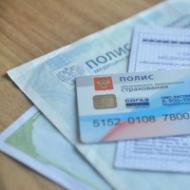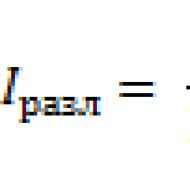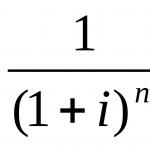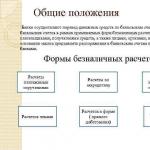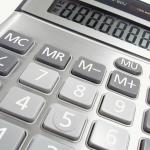
Where is the profit reflected on account 99? When is accounting entry D99 - K09 made?
How is the final financial result of an enterprise’s activities for the year formed? How are the results summed up? In this article, we will take a closer look at account 99 “Profits and Losses”, why it is needed, and what transactions in account 99 are reflected during the year. Accounting for the financial results of an organization's activities shows the company's effectiveness.
In the last article we looked at it, where I already indicated the connection between the accounts. 90 and 99. We also looked at and saw the connection between the count. 91 and 99. Let's move on.
By the way, in the near future we will deal with .
Accounting for the financial results of an enterprise's activities
The financial result for the month is formed using the account. 99.
What does the financial result consist of?
- financial results for main activities,
- other income and expenses.
- income and expenses related to emergency situations at the enterprise (fires, natural disasters, etc.).
- accrued
By debit account 99 losses are reflected, and profits on the loan.
1. When reflecting the financial result for the main activities of the account. 99 corresponds with .
Postings to reflect profit and loss from main activities:
- D90/9 K99- entry to reflect profit from the main activity.
- D99 K90/9- entry to reflect losses from the main activity.
2. When taking into account other income and expenses, account. 99 corresponds with .
Postings for recording other income and expenses:
- D91 K99- other income is taken into account.
- D99 K91- other expenses are taken into account.
3. When accounting for income and expenses related to emergency situations, account. 99 corresponds with various accounts, .
4. When accounting for accrued income tax payments, account. 99 corresponds with .
At the end of the month, the total account balance is calculated. 99, if the final balance is debit, the organization is at a loss this month, if it is a credit, it is in profit.
At the beginning of each month, the balance of account 99 is transferred from the previous month to the current month. Throughout the year, the balance of profits or losses accumulates in account 99 on an accrual basis. At the end of the year 99 closes with final entries on .
Video lesson “Accounting for profits and losses on account 99: typical entries, examples”
This video lesson reveals the rules of accounting for account 99 “Profit and Loss”, examines the corresponding accounts, standard entries and accounting examples. The lesson is taught by a consultant and expert of the site “Accounting for Dummies, Chief Accountant Gandeva N.V. ⇓
You can download the slides and presentation for the video using the link below.
Postings for closing account 99
- D99 K84- final financial result - profit.
- D84 K99- the final financial result is a loss.
At the beginning of next year. 99 opens again.
As a result, on the account. 84, either profit (on credit) or loss (on debit) is reflected at the end of the year. Account 84 is used to distribute profits for any needs of the organization, for example, for payments to founders. Also, if previously on the account. 84 there was a loss, then this year’s profit can cover the loss of previous years.
This is where we end with the study of the Fundamentals of Accounting, we have analyzed the main business transactions occurring in the enterprise, and examined how the final financial result is calculated. Before we start preparing accounting and tax reporting, let’s look at taxation: what taxes exist and how they are calculated. I suggest you go to section Step 2.-.Dt 99 Kt 99 — this posting is an important component of the balance sheet reformation when summing up the organization’s activities for the year. What are the legal requirements for accounting for profits and losses, what amounts can be attributed to the debit of account 99 and the credit of accounts 68, 84, 91, 09, what nuances characterize these postings - we will talk about all this in our article.
Posting contents debit 99 credit 99
Wiring Dt 99 Kt 99 is formed once at the end of the year when summing up the results and is part of the balance sheet reformation.
In fact, this is an operation consisting of several transactions Dt 99 Kt 99 inside account 99 “Profit and Loss”, depending on the number of subaccounts. The operation in practice is called “Closing accounts”. It consists of assigning the values accumulated in subaccounts to one subaccount, which reveals the final annual financial result.
To understand how this happens, you need to familiarize yourself with the internal structure of account 99 and consider how subaccounts are opened for it.
How the 99 count works and its analytics
The count of 99 is used to summarize results. The resulting performance indicators are included in the financial statements. Accordingly, the analytics device must meet the main goal - the preparation of reliable reporting.
IMPORTANT! The instructions for the Chart of Accounts contain a direct indication of the need to build analytical accounting on account 99 to structure the data included in the financial results report.
Starting from the first month of the year, account 99 serves to accumulate information about the results of the organization’s work. The account accumulates:
- result from sales within the main activity;
- the result of other operations;
- amounts of recalculation of income tax and sanctions.
The account also keeps records of the values defined by PBU 18/02 (if the organization is obliged/decided to apply it):
- conditional expense/income (UR/UD);
- permanent tax liabilities and assets (PNO, PNA);
- write-off deferred tax liabilities and assets (ONO, ONA).
When opening sub-accounts, it is advisable to take into account how information should be grouped and reflected in the statement of financial results (Form 2). At the same time, it is important to follow the legal requirements for recording this information. It is optimal to use the following subaccounts:
- 99.1 “Profit and loss”:
- 99.1.1 “Profit (loss) before tax.”
To take into account the indicators that form the reporting item of the same name, the result of sales for core activities and other operations. - 99.1.2 “Other profits and losses.”
To account for the amounts of recalculation of income tax, tax sanctions, written off by ONO and ONA, grouped in the item “Other”.
Maximum information content is achieved by maintaining analytics on sub-accounts in the context of the component indicators taken into account. Modern software products allow you to conduct analytics within a subaccount without unnecessarily cluttering up accounting.
- 99.2 “Calculation of income tax.”
To account for amounts involved in the disclosure of information on income tax calculations in accordance with PBU 18/02. - 99.2.1 “Conditional consumption”.
- 99.2.2 “Conditional income”.
- 99.2.3 “PNO (PNA)”.
- 99.9 “Balance of profit and loss.”
Movement on account 99 and compliance of its data with reporting indicators
Having examined the internal structure of the account, it’s time to start studying the movement on the account. Let's look at a conditional example of what happens inside the account, how the results are reflected by postings Dt 99 Kt 99 how its data compares with reporting data.
Example:
The final indicators of the organization for the year are given, presented in the table in order of the articles of Form 2.
|
Index |
Reporting line code |
Amount, rub. |
Note |
|
Net revenue |
10 000 000 |
||
|
Cost price |
(9 000 000) |
||
|
Profit (loss) from sales |
1 000 000 |
||
|
Other income |
|||
|
other expenses |
(440 000) |
||
|
including other social expenses |
(40 000) |
The organization did not take into account the amount as expenses to determine taxable profit |
|
|
Profit (loss) before tax |
1 060 000 |
||
|
Current income tax |
(220 000) |
The value is equal to the tax payable on the tax return: 10 000 000 - 9 000 000 + 500 000 - (440 000 - 40 000) = 1 100 000; 1 100 000 × 20% = 220 000 |
|
|
including PNO (PNA) |
40 000 × 20% = 8 000 PNO by amount of social expenditures |
||
|
Other |
tax penalties |
||
|
Net income (loss) |
|||
|
Conditional consumption |
(212 000) |
1 060 000 × 20% = 212 000 |
See also article .
The table below contains entries using recommended subaccounts and example data.
|
Wiring |
Decoding |
|
|
Wiring Dt 90, 91 Kt 99 |
||
|
Dt 90.9 Kt 99.1.1 |
This is how the monthly sales total is summed up, which is added up in account 99.1.1: (10,000,000 - 9,000,000). Note. The example shows a positive result. If a loss is received during the month, then the posting is usedDt 99 CT 90. |
|
|
Dt 91.9 Kt 99.1.1 |
This is how the monthly total for other transactions is summed up, which is added up in account 99.1.1: (500,000 - 440,000). Note. The example shows a positive result. If a loss is received during the month, then the posting is applied debit 99 credit 91. |
|
|
Postings Dt 99Kt 68 |
||
|
Dt 99.1.2 Kt 68 / calculations with the budget |
The amount of penalties determined by the tax inspectorate is reflected |
|
|
Dt 99.2.3 Kt 68 / calculation of income tax |
Reflected PNO |
|
|
Dt 99.2.1 Kt 68 / calculation of income tax |
Conditional consumption generated |
|
For information on how to keep income tax records on account 68, read the article .
When closing subaccounts, it is necessary to generate transactions in the format in question Dt 99Kt 99:
|
Wiring |
|
|
Dt 99.1.1 Kt 99.9 |
|
|
Dt 99.9 Kt 99.1.2 |
|
|
Dt 99.9 Kt 99.2.1 |
|
|
Dt 99.9 Kt 99.2.3 |
The turnover and accumulated balance of account 99 before the reformation and after the closure of sub-accounts, as well as the comparability of account data with the lines of Form 2 are shown in the table:
|
Debit turnover |
Loan turnover |
Debit balance |
Credit balance |
Reporting line code |
|
|
Before the Reformation |
|||||
|
conditional flow |
|||||
|
After closing |
|||||
|
(1 000 + 212 000 + 8 000) |
(1 060 000 - 221 000) |
||||
As a result of an operation from a series of transactions in the format Dt 99 Kt 99 in subaccount 99.9 a credit balance was formed equal to the net profit for the year in the amount of 839,000 rubles. The amount must correspond to line 2400 of Form 2.
Debit 99 credit 84
This is the last posting of the year in the chain of postings of the reformation procedure. It contains good news: the organization earned a profit for the year. For the example given, an entry is drawn up reflecting retained earnings: Dt 99.9 Kt 84 - RUB 839,000.
If the organization operates at a loss, then account 99.9 has a debit balance equal to the uncovered loss. It is posted to the debit of account 84: Dt 84 Kt 99.9.
Debit 99 credit 09
This is a posting for writing off the amount of ONA. PBU 18/02 describes 2 cases of write-off of IT:
- If the tax rate changes, then the accumulated IT is changed by recalculating the balance of deductible temporary differences (DTT) at the new rate. The difference between the accumulated and recalculated amounts is posted to account 99, as required by the regulations.
- If the asset that determined the accrual of the tax is disposed of, then the tax is subject to write-off to the extent that the profit for taxation will not be reduced in accordance with the legislation of the Russian Federation.
If the accounting of VVR and ONA is carried out correctly, then IT, as a rule, is completely repaid with a decrease in VVR. If accounting errors have been identified, then when they are corrected, it may be necessary to write off IT as a loss.
Cases of write-off of IT of the same kind are reflected in the same way in accounting: Dt 77 Kt 99.
Results
It is difficult to overestimate the importance of creating analytical accounting on account 99. Highly informative analytics is the key to high-quality accounting reporting that provides reliable information for its users. Correct reflection of analytics is ensured, among other things, by postings of the format Dt 99 Kt 99.
Characteristics of account 99
Account 99 in accounting is an active-passive profit and loss account, i.e. it can have both a debit and a credit balance. The contents of account 99 are described in detail in the current Chart of Accounts, approved by order of the Ministry of Finance of the Russian Federation dated December 31, 2000 No. 94n.
In accordance with this document, information is accumulated on account 99:
- about the financial results that the enterprise receives from the main type of economic activity (in correspondence from account 90);
- on other income and expenses for the reporting period (in correspondence from account 91);
- on penalties imposed on payments to the budget and extra-budgetary funds, accrued payments and recalculations made for income tax (in correspondence from account 68).
For organizations in the agricultural sector, there is a Chart of Accounts, which was approved by the Ministry of Agriculture dated June 13, 2001 No. 654. According to this plan, when taking into account debit-credit turnover when calculating the financial result on account 99, it is also necessary to take into account income and losses from force majeure and other emergencies (fire, natural disasters, etc.). Income from an emergency includes insurance compensation received by the company and income from the sale of materials during the dismantling of destroyed buildings and structures. Costs in such situations include losses that are not compensated by the insurance company.
Analytical accounting for accounting 99 is structured in such a way as to ensure the generation of information for drawing up the final report on financial results.
Account 99: what does debit and balance show?
The debit of account 99 shows the expenses and losses of the organization. Expenses are the total amount of expenses that were incurred by the enterprise for a certain period (year, quarter, month) based on the results of its activities. These costs include funds spent on raw materials and materials, acquisition of fixed assets, compensation of workers, operation of vehicles, etc. Expenses are in correspondence under the loan with accounting accounts 01, 03, 10, etc. For example, as a result of an emergency the company lost its own products - Dt 99 Kt 41.
The most important accounting indicator is the accounting balance 99, which is the difference between financial profit and expenses. This indicator appears as a result of the production and sale of goods. The balance is determined at the beginning and at the end of a certain time interval, and, accordingly, is called initial or final.
The goal of every organization is to make a profit. If the balance of account 99 at the end of the reporting period turned out to be a debit, this means that the level of profit was lower than the level of costs. If the balance is negative, the company made a profit for the selected period of its operation.
Below is the answer to the question, Kt 99 of the account is profit or loss.
Is credit a profit or a loss? What does account credit 99 show?
Account credit 99 shows the company's income. Income is the sum of all income received by an organization into a bank account for a specific time interval. Income includes: revenue, profit from transactions with securities, interest received on deposits, income from leasing property, etc. The credit of account 99 is in correspondence with accounting accounts 90, 91, 73, etc. For example, income received from Sales of goods produced or services provided are reflected by posting Dt 90 Kt 99.
Don't know your rights?
Thus, it is important to answer the question: is the credit of 99 accounts a profit or a loss? The loan shows the company's profit, i.e. it has a positive credit balance at the end of the reporting period.
Closing the reporting period
At the end of each reporting period, companies must close account 99, and at the beginning of the next year, open it again. These operations are necessary in order to have an idea of the results of the enterprise and its level of profitability.
Accounting reporting periods coincide with tax periods, therefore, resetting account balances 99 to zero is also necessary in order to make timely and complete tax payments.
The balance at the beginning of the next period should be zero. To close account 99, you must first close the accounts associated with it. These include:
- Account 90 “Sales”. This reflects income from the sale of goods and services that were produced as a result of the company’s activities. To detail accounting transactions for this accounting account, subaccounts are opened for it: 90.1, 90.2, 90.3, 90.9.
Account 90 is closed with the following transactions:
Dt 90.1 Kt 90.9
Dt 90.9 Kt 90.2
Dt 90.9 Kt 90.3
- Account 91 “Other income and expenses.” It is formed on the basis of other income and expenses of the company. The most used subaccounts for this accounting account are: 91.1, 91.2, 91.9.
After these accounts are closed, the total for account 99 and the final balance are displayed. If a positive amount is obtained from the debit account, then a loss is formed; if such a value appears on the credit account, a profit is formed.
Then a posting is made to account 84, where retained earnings (Dt 99 Kt 84) or loss (Dt 84 Kt 99) are reflected, and the account is closed. The balance on it remains zero.
Subaccounts to account 99: which one reflects the financial results of the reporting year?
According to the current Chart of Accounts, subaccounts can be opened for account 99:
- 1 “Profits and losses from ordinary activities” is intended to account for the financial results obtained from the sale of goods, provision of services, and performance of work.
- 2 “Profits and losses from operating activities.” This takes into account the financial result, which is identified on account 91 (for example, from the sale and other write-off of fixed assets, intangible assets, from the sale of materials, etc.).
- 3 “Profits and losses from non-operating transactions” reflects the financial result from non-operating transactions on account 91.
- 4 "Extraordinary Income". This sub-account keeps records of emergency income broken down by type (from emergency incidents).
- 5 "Extraordinary expenses".
- 6 “Payments for income tax and financial sanctions” displays transactions for calculating income tax and penalties.
- 7 “Profit and loss of the reporting year” reflects the financial result at the end of the reporting period.
***
Which account is the profit (loss) of the enterprise reflected in? Account 99 is intended for this purpose, which reflects the financial results of the organization for a certain period of time. This result is then entered into Form No. 2 of the financial statements “Report on Financial Results”. This accounting account is active-passive: a positive debit balance means a loss at the end of the financial period, and a positive balance on a credit means a profit. At the end of each reporting period, it is necessary to close account 99 to reset the balances. Sub-accounts can be opened to this account for a more detailed reflection of transactions.
In modern world can not imagine activities of an enterprise without accounting. Correct reporting allows you to have a clear picture of the company’s activities, understand its weaknesses and hidden opportunities, thereby improving its efficiency, increasing income, and reaching a new level of business.
The result of the activity of any enterprise is profit. Profit is the difference between and the costs of producing goods or services, is the most important indicator for understanding the financial independence of a company. The laws of the Russian Federation in the field of accounting determine that profit should be reflected on 99 account Chart of accounts.
Regardless of the type of activity of the enterprise and the form of education, the accountant is obliged to open an account 99 and display transactions on it reliably and in full. Account transactions reflect the profit or loss of the enterprise in the reporting period, namely:
- Income and expenses for ordinary activities, which are determined by the statutory documents.
- Profit and loss from emergency activities (elimination of emergency situations, insurance amounts, loss of equipment, goods, forced shutdown of production lines).
- Payments and recalculations for income taxes and tax penalties, deferred liabilities.
The Profit and Loss account is active-passive, that is, the transaction can be shown as a credit or debit - it depends on the situation. The final result of the activity reflects the balance. In the debit of account 99, it is necessary to display actions on expenses and losses of the company.
Expenses are the sum of all costs that were incurred by the company during the reporting year (month, quarter) as a result of its work. These expenses are the costs of raw materials, purchase of equipment, payment to employees, operation of transport, etc. Expenses correspond to the loan with accounts: 64, 03, etc. An example in the debit of account 99 is the loss of goods that occurred as a result of an emergency ( Dt. 99 / Kt. 41).
In credit accounts, they show the firm's income. Income- these are all receipts to the current accounts that the enterprise has within the specified period. Income examples: revenue, profit on transactions with securities, interest on investments, rental income, etc. The account credit is linked to the following accounts: 90, 72, 8, etc. Example: the action on the loan is to receive profit from the sales of goods or services produced (Dt. 90 / Kt. 99).
Balance
Balance is the difference between profit and expenses that appears as a result of production and sales of products. The balance is considered the most important indicator in financial statements. The balance can be initial and final, which is determined at the beginning and at the end of a given time period.
Of course, any enterprise strives for profits to exceed expenses. If the account balance turns out to be debit at the end of the reporting date, this means that the level of costs exceeded the level of profit. In this case, the balance is negative - the company did not make a profit during the reporting period of its activities. If the balance is credit, then the company reflects profit with a plus sign in the report on the results of its work.
At the end of each period, organizations it is necessary to close the account and open it again at the beginning of the year. This is done in order to understand how the enterprise operates and what its level of profitability is. Since accounting periods are equal to tax periods, it is easy to understand that it is also necessary to reset balances in order to make tax payments on time and in full.

The opening balance for the future period must always be zero. In order to close a 99 account, you must first close the accounts that are associated with it. Such accounts include:
90 "Sales"
This account displays income from the sale of goods and the provision of services that were produced as a result of the organization's main activity. For ease of accounting, subaccounts are opened on this account: 90.1, 90.2, 90.3,90.9.
Until July 2017, depreciation on this equipment in accounting was 216,000 rubles, in tax accounting – 240,000 rubles, the calculated temporary difference was 24,000 rubles. The deferred tax asset amounted to:
24,000 * 20% = 4800 rub.
Since the company sold this equipment in July 2017, it needs to write off the deferred tax asset. This is done with the following wiring:
Dt. 99 Kt. 09 = 4800 rub.
Example 2: the company Sintomat LLC produced and sold goods worth 2,500,000 rubles in 2016. Value added tax in the period amounted to 500,000 rubles. Production costs – RUB 1,080,343. Operating costs, management costs, rental costs and transport are equal to RUB 523,487.
Account 90.1 - Balance Kt - 2,500,000 rubles.
Account 90.2 - Balance Dt - 1,080,343 rubles.
Account 90.3 - Balance Dt - 500,000 rubles.
Account 44 - Balance Dt - 523,487 rubles.
The account is closed as of December 31, 2016 following diagram:
Dt. 90.2 Kt. 44 - 523,487 rub.
Dt. 90.9 Kt. 99.1.1 - (1,080,343 + 500,000 + 523,487) - 2,500,000 = 396,170 rubles.
Total, credit balance, that is, the company made a profit in 2016 in the amount of 396,170 rubles. Final wiring upon account closure it will be:
Dt. 99 Kt. 84 - 396,170 rub.
To determine the amount of income tax liability for the reporting period, it is necessary to fulfill this wiring:
Dt. 99.1.1 Kt. 68 - 396,170 * 20% = 79,234 rub.
When maintaining accounting records, it is difficult to overestimate the importance of correct execution of account 99 “Profit and Loss”, since it is by it that the result of the enterprise’s work is assessed, further plans are made for the effective conduct of business and the amount of tax liability for income tax is determined.
Additional account information is provided below.





